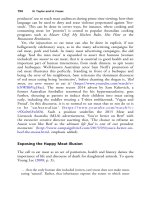The palgrave international handbook of a 487
Bạn đang xem bản rút gọn của tài liệu. Xem và tải ngay bản đầy đủ của tài liệu tại đây (27.1 KB, 1 trang )
Animals in War
489
The French military, then possessing fifteen thousand dogs in its employ,
destroyed the animals as its great war machine demobilized. The vast quantities
of dogs used by the British, Germans, Italians, and Russians faced the same
fate. The actual number will never be known since these events were never
accurately recorded. (1996, p. 29).
Certainly, no dog volunteered to be ‘destroyed’. The hazy uncertainty
about the number of dogs killed in this way is part of what permits such
events to occur. Indeed, Lemish makes a crucial point here that informs
every element of this chapter and that impacts this topic more generally:
We have too little information about the participation of animals in war.
Thus, histories like Lemish’s, and projects like the present book, help to
inform the public about these events, raising animal abuse into the
visible sphere, which often leads to improved conditions for the future.
For instance, consider the change in U.S. military policy with regard to
dogs. The U.S. canine program in Vietnam became notorious when, at
the end of the hostilities, it classified the 4,000 or so participating dogs
as ‘equipment’, leaving nearly all of them behind, in country. Burnam
notes that this meant many of the dogs were either euthanized or eaten,
according to local practices (2000, p. viii). But, spurred in part by the
agitation and activism of U.S. veteran dog-handlers from Vietnam, the
U.S. legally changed its policy in 2000, permitting dogs to be eligible for
adoption after they complete their military service (McCombs 2000).
Such changes offer hope for a better future.
Other Animals: Prevalence, Nature,
and Explanations
To further suggest the range of animal participation in war, and to reinforce
the central arguments above, this section presents several anecdotes about
other animal participation in war, with particular attention to systematic,
biopolitical forms of abuse.
Mules often underwent treatment much akin to that of horses, and it often
resulted in systematic suffering and abuse. In the U.S. Civil War, for instance,
mules were commonly used as transportation animals, but they frequently faced
neglect. Animals were often poorly fed: ‘More than 10,000 Union mules died
of starvation’, for instance (Kistler 2011, p. 290). And the mules were often
poorly treated in other ways. Kistler reports that many of the mules who died
‘were too young to work’. They were ‘not strong or developed enough for the









